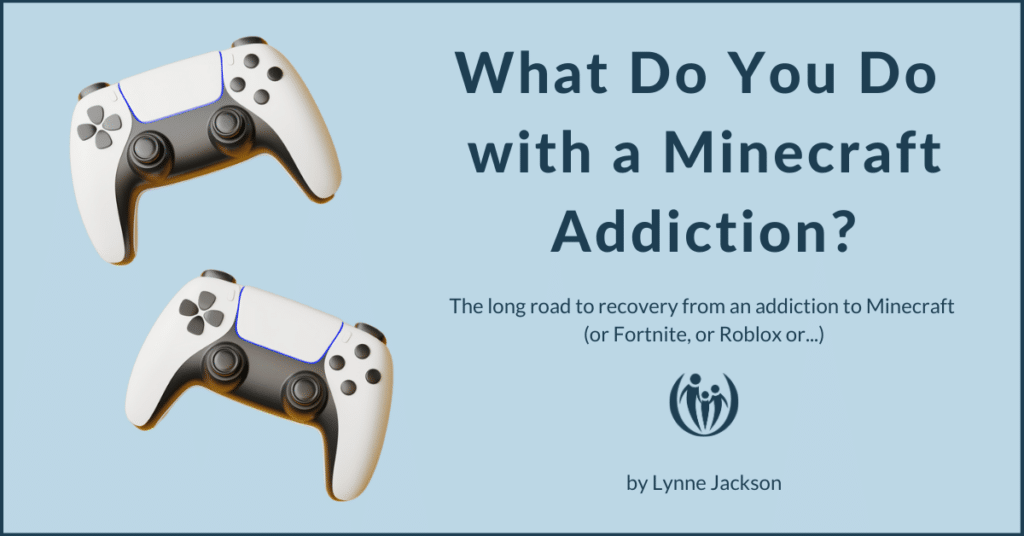
What Do You Do with a Minecraft Addiction?
The long road to recovery from an addiction to Minecraft (or Fortnite, or Roblox, or...)

Does it feel like you’ve got a Minecraft addict in the house? Or maybe it’s some other online game, like Fortnite or Roblox. Online gaming addiction is real. Your child’s screen habit probably started out innocently enough. Over time it may have escalated to a level that pits you against each other and threatens the joy and connection in your relationship.
Maybe you read our article about creative ways to nurture healthy boundaries around screen time for younger children, and now you’re shaking your head saying, “My kid is beyond that point…he is addicted.”
Whether you’re worried your child is addicted to Minecraft or a different game, you probably feel frustrated or possibly so overwhelmed that you’ve essentially given up trying to set boundaries. If so, you are not alone!
Why is Minecraft (and other online games) so addictive?
Considering how games are constructed, it’s not surprising that video game addiction can easily happen. With revenue from gaming now well over $150 billion a year, companies have lots of money to spend on making these games enticing and addicting. The National Institute of Health states, “the level of dopamine released… when playing a competition-like video game is comparable to that provoked by psycho-stimulant drugs.” Parents are up against an intense challenge. In light of this, try giving yourself a lot of grace. And give grace to your kids too!
In addition to increased dopamine levels when playing Minecraft, there’s no end goal or number of minutes that marks the end of the game. Instead, there’s always something more you could do or improve because why not? This makes Minecraft even more addictive.
Signs of video game addiction
Video game addiction is a common concern we hear from parents. Let’s start with looking at a summary of the signs of video game addiction listed by WebMD:
- Child uses games to improve mood, and is irritable, angry, or even aggressive when he cannot play.
- Child frequently thinks and talks about games when not playing – life is focused on the games.
- Social interactions, previously preferred activities, or schoolwork are negatively impacted.
- Child lies about playing time.
Do any of these signs feel familiar? Have you observed any of these with your child’s behavior in regard to video games? If so, where do you start? Read on to hear how one family took successful measures to tackle this tough issue and eventually raised a responsible, independent young man!
A note to the parent who feels hopeless and guilty about the level of conflict when it comes to setting limits on video games in your home: You are not alone, and you are not a bad parent. What should you do? Even if many of these ideas are not a good fit for your family, we have additional ideas for you at the end under the heading, “If you feel hopeless…” So read on – there is hope!

How one family helped their son overcome his Minecraft addiction
Some kids can regulate their computer use with fairly minimal guidance. Dillon was not one of those kids. At fourteen, he was extremely intense and obsessed with online interactive video games, especially Minecraft. He also played an empire-building game that wasn’t as time-consuming but needed frequent daily attention.
No matter how hard Dillon’s parents, Kate and Marc, tried to help him scale back, the rage and frustration could escalate whenever it was time to turn off the games. There was never an endpoint or feeling of lasting success, no matter how much time was given. It was almost like giving a kid access to pornography or, as Kate observed, “one sniff of cocaine”. Dillon was incredibly persistent in begging and pleading for more time.
The games caused strong negative emotions in and of themselves, not just the limits. Another player would do something mean. Or destroy his empire in the night. Or the system would have a glitch. Or the timer, to tell him it was time to be done, would go off at a crucial moment. Any one of these things could negatively impact their family for the rest of the day.
Even when it was turned off, Dillon always knew those Minecraft battles were happening online without him. It consumed his mind and his friendships, and nothing else seemed nearly as important to him. Kate described it, “…all of real-life paled tremendously in comparison, even when we tightly restricted his time on Minecraft. It still took up lots of brain time. And created endless conflict.”
A difficult decision and a three-fold strategy for addressing the Minecraft addiction
Kate and Marc came to the difficult decision that they could no longer allow the screens in their house to be used for addictive online games. Not only that, Kate and Marc also felt strongly that “these are important years of brain development and general maturation. ‘Use it or lose it’ is a very real phenomenon. Kids really need that development!”
Knowing this would be a difficult and long-term conflict, Marc and Kate were thoughtful in how they implemented this new decision to prohibit online gaming in their home. They presented it to Dillon carefully and gradually, receiving coaching at the same time, to maintain perspective and focus.
Together their family developed a three-fold strategy:
1. Evaluate current activities, Minecraft or otherwise
Marc, Kate, and Dillon started by developing a system and a chart to rate all their different activities for their cognitive, physical, spiritual, and social benefit. This was based on Luke 2:52, which described Jesus’ development: “And Jesus grew in wisdom and stature, and in favor with God and man.”
Then they divided the benefit by the length of time it consumed. The higher the benefit and the more limited the time investment, the higher the ranking.
Teaching Sunday School together ranked highest in priority, and playing video games ranked lowest (even by Dillon’s admission).
“I have the right to do anything,” you say—but not everything is beneficial. I have the right to do anything,” but I will not be mastered by anything.
This family brainstorming session helped Dillon understand the relative value of different activities and the importance of honest evaluation. It was a concrete way to help him begin to understand why screen obsession could be a problem. He and his parents worked together on a plan to adjust family priorities and time use. (This did not make this process smooth sailing, but it was a helpful, wisdom-building start.)
A good scripture to include in a discussion like this with your kids is I Corinthians 6:12. The Apostle Paul explains that we are accountable to God for how we spend our time and use our bodies. “I have the right to do anything,” you say—but not everything is beneficial. I have the right to do anything,” but I will not be mastered by anything.
This scripture implies two key questions to ask about any activity.
- Is this truly beneficial for me and my long-term good (not just short-term pleasure)?
- Is it possible the activity is starting to control me?
2. A three-week family technology fast
It may come as no surprise, but research has revealed that “One of the biggest predictors of adolescents’ screen use is their parents’ screen use,” says Jason Nagata, a pediatrician at the University of California at San Francisco and the lead author of the study. He also says, “Parent screen use, family mealtime screen use, and bedroom screen use were associated with greater adolescent screen time and problematic social media, video game, and mobile phone use.”
When parents are willing to sacrifice their own screen time to help their struggling child, that sacrifice speaks loudly of compassion, humility, and commitment.
Together Marc, Kate, and Dillon all experienced the impact of turning off their screens (except for workplace and school use.) They chose a busy time of the year when Dillon would likely be distracted by other things. During the technology fast, Marc and Kate went out of their way to provide many fun family activities on the weekends and during free time. These activities included sports events, social gatherings, board games, outdoor games and activities, special foods, time together, and so on. This created bonding experiences that helped reinforce the value of relationships over screen time.
FREE Outdoor Activities List
Need a creative boost to your outdoor activities list? Check out our FREE downloadable PDF with over 60 ideas you can start trying today.
3. Extensive, creative alternatives to technology
Once they completed the fast, Marc and Kate wanted to make the intentional restriction of online gaming at home more tolerable and help Dillon accept the change without lasting bitterness. It’s easier to say “No” when you have a bigger “Yes” focused on the vitality of real three-dimensional life and God’s purposes for your child.
- Marc and Kate gave Dillon time to transfer his empire to someone else.
- They made an ongoing effort to be available for the fun family activities they developed during their family technology fast.
- They helped him pursue a faith-based, competitive card game, at times playing with him and other times traveling so he could participate in tournaments.
- They got him a mini pool table for three-dimensional fun with family and friends.
- They minimized how much they controlled his other activities or activities at other people’s houses. Kate added, “And we prayed an awful lot!”
- They made plans for getting a puppy. When the screen changes were first implemented, this was about the only other thing Dillon was really interested in. The eventual arrival of an adorable little golden retriever helped significantly as he focused on the challenge of training his new pup.
- They supported his involvement in an outdoorsy Bible camp. Dillon probably would never have decided to volunteer there if he’d known he could be home battling people at Minecraft and developing his empire. Camp was a fantastic growth experience that he chose for the next three summers as he became a young man who had the desire to bless others with his life.
- They generally encouraged more three-dimensional creativity. Like this NASA engineer who found a creative way to keep squirrels away from his bird feeders
Help your child feel loved as they struggle to overcome a gaming addiction!
Although we’d love to tell you it was a painless shift to get Dillon off of his addictive games – it was just not so. It was really difficult. Really difficult! That was an indicator that their son truly was addicted.
Marc and Kate could have followed the path of many good-intentioned parents who get railroaded by their child’s intensity to fight for the exciting, gratifying, “glowing drug” and simply give in. Both parents prioritized prayer and 8ioi, It took incredible determination and perseverance to help their son as he gradually matured through this challenge.
Dillon’s four phases of growth in recovery from a gaming addiction
There were four phases of growth over time as Marc and Kate incorporated the Connected Families Framework to help their son feel loved and connected:
1. Anger
Addiction is addiction, and no addict thanks someone for taking away their drug. Initially, it was really rough. Dillon reflected back several years later, “I hated you [Mom and Dad] for a while after you took away [access to] my games. It was so frustrating not to have what other kids had!” He suggested to other parents trying to help their kids, “Expect to be hated.”
The key in this phase was Kate and Marc’s patient, empathetic responses to lots of angry, hurtful words from Dillon. They understood his pain. They understood his brain was in a fight/flight state of panic over losing his source of joy, comfort, and excitement. Their response communicated, “Even in your darkest emotions, you are safe with us.”
2. Adjustment
The non-electronic, alternative activities listed above were really important for Dillon to adjust to his new reality. (Looking back, he felt it would have been helpful to have even more options when he had the urge to play electronic games.) Over time he developed a lot of other interests and values, and now has well-established habits of diligence in homework, sports, working out, and socializing. He took up guitar and photography, read a lot more, explored coding and robotics, art and nature, and on and on.
In short, he blossomed, developed healthy self-discipline, and grew a lot of varied brain pathways. His parents’ sacrifice and effort to provide these activities communicated, “You are loved and so worth sacrificing for.”
3. Wisdom
Kate and Marc wrote down six key reasons for the no-gaming policy to remind Dillon when he wanted to resume playing. They began to have monthly discussions about the impact of technology on their lives, sharing research, personal experiences, and family values. They communicated to him their passionate belief, “You are called to so much more in life than addiction to a screen.” (For a resource on guiding relaxed, productive conversations with kids about technology, you can get ideas on this Tech Talk Tuesday blog.)
As a maturing high school student, Dillon began to recognize, “Those games are so rewarding, because the longer you play the more big and powerful you get. It would be great to just play them a little now and then, but I realize you can’t because it just gradually consumes more and more of your time.” Dillon and his parents’ efforts to keep an open dialogue and share their experiences communicated, “You are capable of learning to make wise choices.”
4. Independence
Dillon’s parents increased his digital independence in preparation for college. When using the internet he made reasonable and reality-based choices, with Covenant Eyes for accountability. Kate and Marc’s careful planning to gradually increase his independence communicated, “You are ultimately responsible for your life, not us.”
We have a podcast about this!
Check out Episode 185 of the Connected Families Podcast, “Screen Time and Kids: How to Say YES More Often, While Kids Have LESS Screen Time,” to hear more great information about kids and screen time.
What does life look like after recovering from a gaming addiction?
You might be wondering, “What happened to Dillon when he went to college with all that freedom?” Seven years after his parents began to address this challenge, Dillon was an upperclassman in college. When the pandemic hit, he ended up at home recovering from Covid.
His mom reported to me:
“Dillon made lots of progress on his schoolwork and had a good start on a big paper. I commented to him about how much schoolwork was going to get done this semester with everyone quarantining. He responded, ‘No—most people are just online or playing video games most of the time. I’m thankful for the way I was raised and the choices I’ve made to not get caught up in that again and to make better use of my time.’ Wow. Praise the Lord! I don’t think I ever really thought I would hear him say that. Especially back when things were so hard.”
When I heard this from Kate, I connected with Dillon and asked him his perspective on this change for him. He described a healthy balance now where he can play online for a short time, meet some new friends, and then be done! He shared, “Especially now that I have gotten to college, I have become very grateful for what my parents did. While at school, I have seen so many people who are addicted to screens. It sucks their time away from their homework, friends, and doing things that are more fun. I have been so grateful to have been saved from that addiction and to be able to put my time into better things.”
Building healthy screen habits when kids are young
As seasoned veterans of a very difficult challenge, what is Marc and Kate’s advice for parents?
- Avoid the slippery slope. It’s best if parents avoid letting their kids get immersed in these types of online games. These games often begin with just ‘cute stuff,’ but it is a pretty slippery slope, especially when you start introducing games that are interactive with others who are also playing.
- Seek out a group of peers not addicted to video games, that your child could belong to. “Easier said than done with a tween boy, but with coaching and lots of prayer, God did provide.”
- Prioritize connecting with your child. Kate states, “As I’ve become more aware of some of the brain science, I now realize the vital importance of filling up our son’s joy tank with us being glad to be with him — seeing and celebrating him. I think I was prioritizing the wrong things and wish I could have a do-over to relax with and enjoy him as much as possible. ”
- Be willing to sacrifice your own screen privileges and time. Mentor and model healthy screen habits and diverse interests for your child.
- Strengthen your own sense of “okay-ness” outside of your child’s reactions to you. This will help you be more peaceful in the tough moments. (Our Grace and Truth for Moms online course is great for that.)
- Watch the movie Inside Out 2. It is a great illustration of some of what’s going on with your child’s emotions and feelings at this age. Enjoy and maybe discuss with your child.
And where is Dillon now?
Kate shared this update: “Dillon is 25 and about to be married! Time flies, and it’s surprising how kids can take on our values and training even when it doesn’t seem like they’re going to. How thankful I am that his brain and identity got filled with so much more than that one very fun but devastating activity.
I’m sure his fiancé is also grateful. She is a wonderful young woman and probably wouldn’t have been attracted to him otherwise. Board games, outdoor activities, dogs, and friends have all been an important part of their relationship… and now he’ll be equipped to navigate screen challenges if they decide to have a family.” 😉
Taking the next step in your family
What resonates with you in Marc and Kate’s story? Are there technology challenges in your home? If so, perhaps you could identify with one of these responses:
- I have young kids and want to establish solid early habits and guidelines about technology to prevent addictive patterns.
- I want to start having more discussions about what’s important in life and how technology impacts our family life.
- I want to try a technology fast and work toward strong limits on screen time for my addiction-prone child.
If you’re feeling hopeless and discouraged about unhealthy gaming habits
If the idea of setting reasonable limits on screen time doesn’t seem possible or would deeply fracture your relationship with your child, there still are helpful things you can do that flow from the Connected Families Framework:
FOUNDATION: Start by confessing and asking forgiveness for the times you’ve been angry, condescending, or controlling in your efforts to regulate screen time or for ways in which you’ve been obsessed with your own screens. Do this in a sincere but light-hearted way so the discussion is not filled with anxiety and discouragement.
Ask yourself, “What’s it like to be my child right now?” Does your tone of voice, facial expression, and body language invite a respectful interaction? Lean into prayer and faith by asking God for wisdom and discernment for what to do when your child is playing video games.
CONNECT: Prioritize connection over all else! Model putting your screens down, looking at your children, and really listening to anything they have to say. You might say something like, “Wow, that must have been frustrating.” “I’m glad you shared that.” Ask non-threatening questions, “What else do you want me to know about that?”
Go out of the box to offer creative, three-dimensional ways to have fun together, especially if it’s a little outside your comfort zone. For example, we’ve had paintball battles, played with foam swords and homemade javelins, and gone ziplining with our boys. There are ways you can connect with a child who doesn’t seem to want to connect with you. Keep your eye out for interests your child has where you could join them. If they will let you, find out what games they are enjoying and play with them. (You both might get some good laughs out of it!)
Even if your child says “No” to your offers, don’t give up. You can smile and say, “Okay, maybe some other time.” A calm, non-defensive response shows that you are interested in spending time with them, but your emotional well-being doesn’t rise and fall with their acceptance or rejection of you!
COACH: Model and live out how God has called you and talk about the fulfillment you experience. Express confidence in your child’s ability to grow into God’s purposes in real, three-dimensional life. Look for opportunities to develop their natural gifts and also to serve together.
Learn to ask good questions to build wisdom. You can sign up for Tech Talk Tuesday on the Screenagers website. It might seem uncomfortable to sit down every Tuesday and have a structured “Now we’re going to talk about screen time” chat. But thinking through the example questions will help you learn to have relaxed, value-building conversations with your kids about life and screens.
CORRECT: Do not use losing screen time as the go-to consequence for any misbehavior because that communicates it is the only thing in life that’s valuable. Research shows that “Parental use of screens to control behavior (e.g., as a reward or punishment) was associated with higher screen time and greater problematic video game use.”
However, do set expectations for your child to contribute to the family and get chores done. Monitor and set limits with grace and compassion. Research also shows that “parental monitoring of screens… and limit-setting of screens was associated with lower screen time and less problematic social media and mobile phone use.”
There is always hope
If your child is truly addicted, this is not an easy road. But it’s also not a hopeless one. This viral TED talk, “Everything you think you know about addiction is wrong” is a fascinating perspective that will bring insight and encouragement.
Whatever your particular challenge may be, please remember – there is always hope! Never stop having faith, hope, and love for your struggling child.
“And now these three remain: faith, hope and love. But the greatest of these is love.”
God cares deeply about your family, and we are here to help. Parenting kids through tough issues does not have to be a journey you take alone!
© 2016, 2021, 2024 Connected Families







